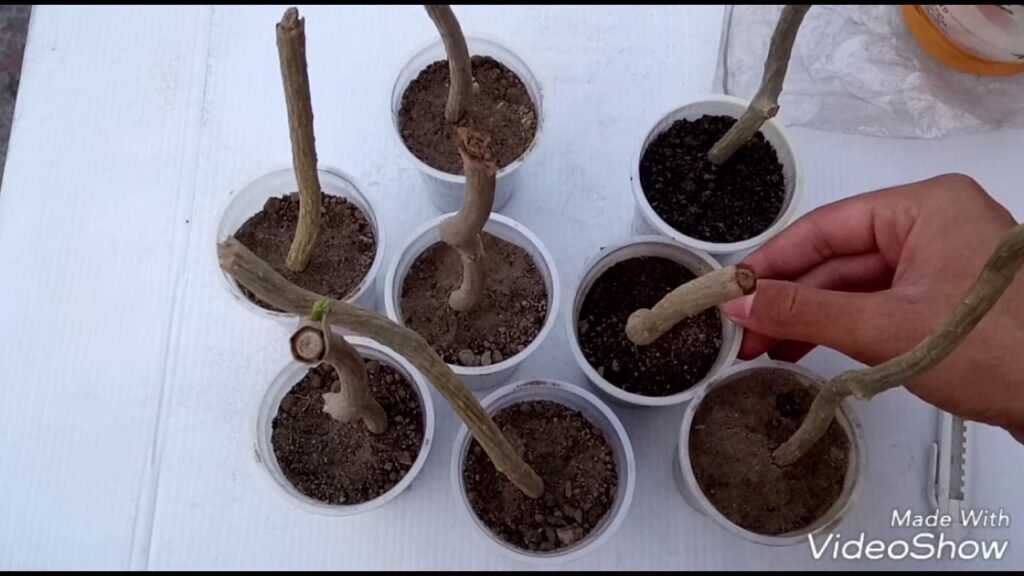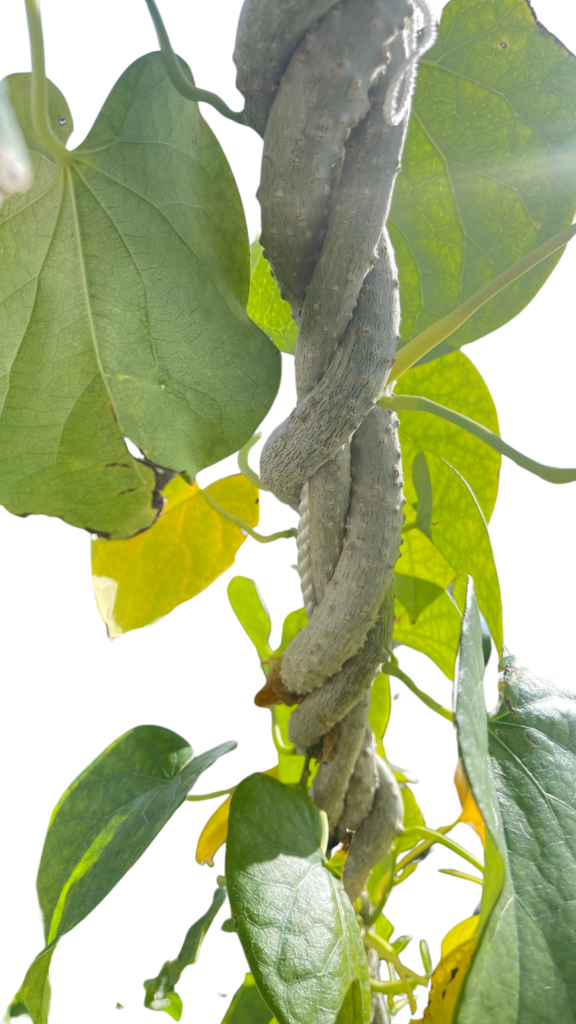TL;DR: Planting Giloy Cuttings
To plant Giloy cuttings, start by selecting a healthy stem about 5-7 inches long with at least two nodes (where leaves attach). Cut it at a 45-degree angle for better rooting. You can optionally apply a rooting hormone to the cut end to help roots develop faster. Plant the cutting in a potting mix or a mix of mud, sand, and dry cow dung in a 1:1:1 ratio, and keep it in a bright but shaded place, misting regularly to keep the soil moist. Rooting typically takes 4-5 weeks, after which you can transplant it to a larger pot or garden bed once new leaves appear.


TL;DR: Caring for Giloy Plant
Once planted, water the Giloy only when the top soil is dry to avoid overwatering. It thrives in full sunlight but should be protected from intense midday sun in summer; if indoors, place it near a sunny window. Since it’s a climber, provide support like a trellis or tree for it to grow on. Fertilize with a balanced fertilizer every 2-3 weeks during the growing season, and prune regularly to encourage new growth and maintain shape. Watch for common pests like aphids and mealybugs, and diseases like leaf spots and powdery mildew, using organic methods to control them if needed.
TL;DR: Other Detail To Note
Giloy is a deciduous plant, meaning it naturally loses leaves in certain seasons. Don’t worry though, this is normal and your giloy is fine. This plant is extremely resilient.
Comprehensive Guide: Planting and Caring for Your Giloy
Propagation from Cuttings
Propagating Giloy from stem cuttings is considered the most effective method, particularly during the summer months of May to July. The process involves the following steps:
- Selecting and Preparing the Cutting: Choose a healthy, fresh stem with a thickness similar to a pencil, measuring 5-7 inches long and having at least two nodes. Nodes are critical as they are the points where roots are likely to develop. Make the cut at a 45-degree angle to increase the surface area for rooting. Optionally, apply a rooting hormone, such as indole-3-butyric acid (IBA) at 2500 ppm, to enhance root formation, though this is more technical and may not be necessary for home gardeners.
- Planting the Cutting: Plant the cutting in a suitable growing medium. Recommended mixes include a potting mix or a combination of mud, sand, and dry cow dung in a 1:1:1 ratio, which provides good drainage and nutrient content. Use small containers like poly bags (4×6 inches) for initial rooting. Ensure the cutting is planted deep enough to cover at least one node, with the cut end buried in the soil.
- Initial Care for Rooting: Place the cutting in a bright but shaded location to protect it from direct sunlight, which can dry it out. Mist the soil regularly to keep it moist but not waterlogged, as Giloy is sensitive to excessive moisture. Rooting typically takes 4-5 weeks, during which the cutting should start showing signs of new growth, such as emerging leaves.
- Transplanting: Once the cutting has rooted and developed new leaves, which usually takes about 6-8 weeks, it can be transplanted into a larger pot or directly into the garden bed. Ensure the new location has well-draining soil and is ready to support the plant’s climbing habit.
Ongoing Care for Giloy Plant
After establishment, Giloy requires specific care to thrive, given its climbing nature and medicinal value:
- Watering: Giloy does not require frequent watering. Water only when the top soil feels dry to the touch, typically every few days depending on climate. Overwatering can lead to root rot, so ensure good drainage, especially in pots. In tropical conditions, it may need less frequent watering due to higher humidity.
- Light and Temperature: Giloy prefers full sunlight for optimal growth but should be protected from intense midday sun during summer to prevent leaf scorch. If grown indoors, place it near a sunny window to ensure it receives adequate light. It thrives in warm temperatures between 70-85°F (21-29°C) and is sensitive to frost, so protect it from extreme cold, especially in temperate regions.
- Support and Training: As a climber, Giloy needs support to grow properly. Provide structures like trellises, fences, or even trees (preferably neem or mango, as traditionally noted) for the vine to climb. This support is crucial for achieving higher yields and maintaining the plant’s health, as it can grow rapidly to about 20 feet.
- Fertilization: Feed the plant with a balanced, all-purpose fertilizer or compost once a month. During the growing season (spring and summer), increase fertilization to every 2-3 weeks to support vigorous growth. Organic fertilizers are preferred to maintain the plant’s medicinal properties and avoid chemical residues.
- Pruning: Regular pruning is essential to encourage bushier growth and remove dead or diseased parts. Prune in August-September when the leaves begin to fall, cutting stems about 30 cm above the ground. This not only helps maintain the plant’s shape but also prepares it for the next growth cycle, and the pruned stems can be used for medicinal purposes.
Pest and Disease Management
Giloy, like many plants, can be affected by pests and diseases, which require monitoring and control:
- Common Pests: Watch for aphids and mealybugs, which can infest the leaves and stems, sucking sap and potentially weakening the plant. Signs include sticky residue on leaves or visible insects. Use organic insecticidal soap or neem oil to manage infestations without harming the plant.
- Common Diseases: Look for leaf spots, which appear as dark spots on leaves, and powdery mildew, a white powdery coating on leaves, both of which can affect plant health. Ensure good air circulation and avoid overhead watering to prevent these fungal issues. If detected, treat with organic fungicides or remove affected parts.
- General Maintenance: Remove dead or damaged plant parts regularly to prevent disease spread. Avoid creating waterlogged conditions, as Giloy is sensitive to excessive moisture, which can exacerbate root rot and other issues.
Environmental Considerations
Giloy is a deciduous plant, meaning it naturally loses its leaves during certain seasons, typically in late summer or early autumn. This is normal and not a cause for concern, but it’s worth noting for gardeners expecting year-round foliage. It grows well in light sandy loam soil rich in organic matter with good drainage, and is suited to tropical and subtropical climates, making it ideal for regions with warm, humid conditions.
Usage and Practical Tips
Once established, Giloy can be harvested for its stems, which are used in various forms like powder, juice, or capsules for medicinal purposes. The plant’s rapid growth means it can spread extensively, so regular pruning is necessary to manage its size, especially in smaller gardens. For indoor cultivation, ensure it has enough space and light, and consider using a creeper net for support if outdoor structures are not available.
Wrapping Up
Planting and caring for Giloy cuttings is relatively straightforward, requiring attention to initial rooting conditions, proper support for climbing, and regular maintenance for pests and diseases. By following these guidelines, gardeners can successfully cultivate this medicinal plant, enjoying both its health benefits and its aesthetic appeal in their gardens. Always consult with a horticultural expert or healthcare professional for specific advice, especially if using the plant for medicinal purposes.